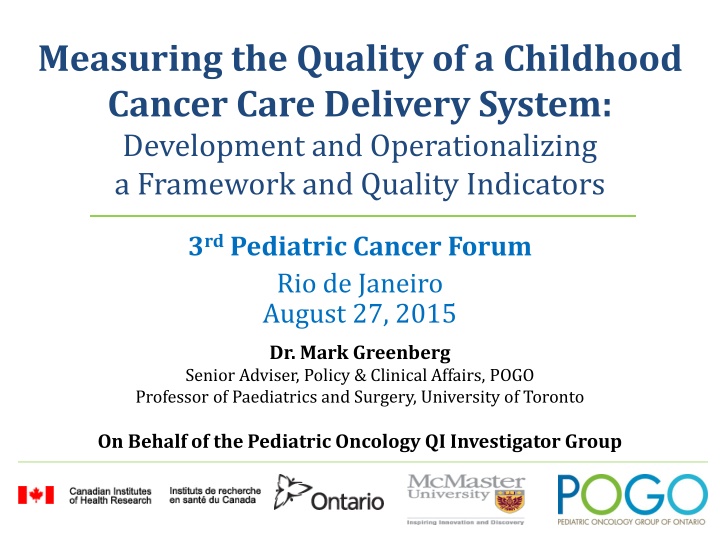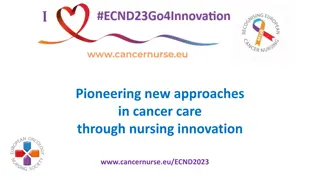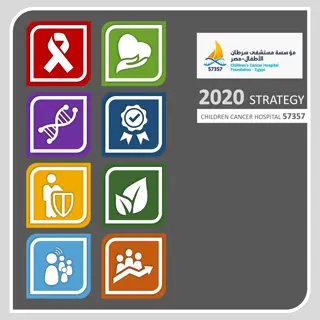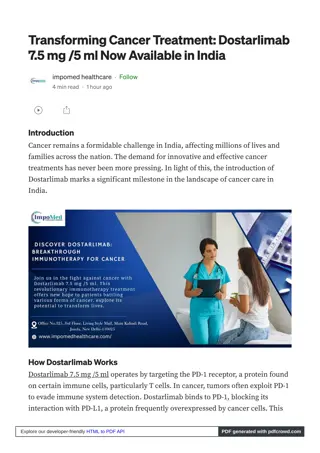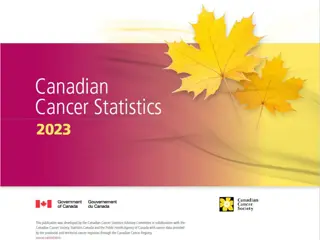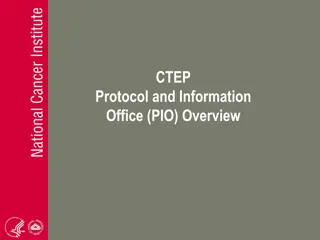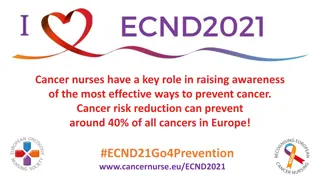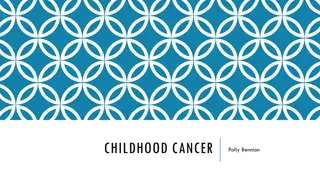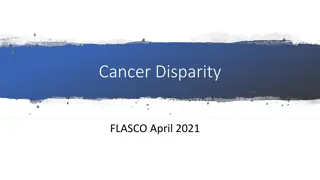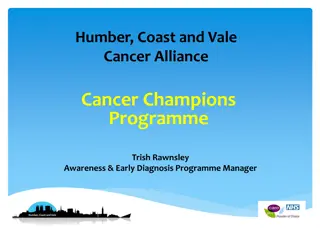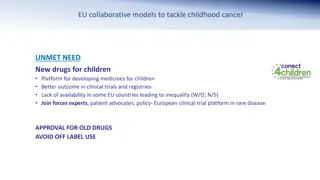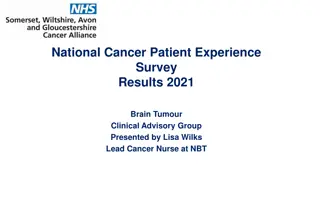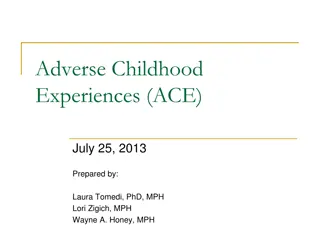Measuring the Quality of Childhood Cancer Care Delivery System
Development and Operationalizing a Framework with Quality Indicators for Pediatric Oncology Care. Explore the phases of quality assessment, indicator development, stakeholder feedback, and implementation. Understand the importance of measuring system performance and ensuring accountability in childhood cancer care. Discover the objectives of creating quality indicators and the intended use for continuous improvement.
Download Presentation

Please find below an Image/Link to download the presentation.
The content on the website is provided AS IS for your information and personal use only. It may not be sold, licensed, or shared on other websites without obtaining consent from the author.If you encounter any issues during the download, it is possible that the publisher has removed the file from their server.
You are allowed to download the files provided on this website for personal or commercial use, subject to the condition that they are used lawfully. All files are the property of their respective owners.
The content on the website is provided AS IS for your information and personal use only. It may not be sold, licensed, or shared on other websites without obtaining consent from the author.
E N D
Presentation Transcript
Measuring the Quality of a Childhood Cancer Care Delivery System: Development and Operationalizing a Framework and Quality Indicators 3rdPediatric Cancer Forum Rio de Janeiro August 27, 2015 Dr. Mark Greenberg Senior Adviser, Policy & Clinical Affairs, POGO Professor of Paediatrics and Surgery, University of Toronto On Behalf of the Pediatric Oncology QI Investigator Group
Outline 1. Why do this anyway? 2. Phase I Quality Assessment Frameworks 3. Phase II Quality Indicator Development & Framework Selection 4. Phase III Stakeholder Feedback: Modified Delphi Panel Process 5. Next Steps & Implementation 2
Centuries of Bloodletting for the Cure How do we know we are doing a good job? 3
Which Lenses are Necessary? System? Patient outcomes? Nursing? All! Different phases of the cancer journey? 4
What Enabled the POGO Initiative? 1. Well integrated provincial cancer delivery & control system 2. Enduring, evidence based, collegial partnership of treating hospitals 3. POGONIS - Networked Information System and ability to link to other Databases ) Tertiary Centres Satellite Centres CHE O.5 CH, LHSC AfterCare Programs SRH General Profiles OSM H Demographics Patient/ Family Sociographics Patient/ Family WRH SickKids TORCC MCH, HHS CHEO CH, LHSC Disease Characteristics Diagnosis & Stage Status Death Record SRHC GRH KGH MCH, HHS Late Effects KGH Status Markers RVC SickKids Medical Treatments Type, Date and Details Locus of Treatment POGO Centres Satellite Programs CVH Health Service Utilization Data PMH Allied Health Treatments POGO Centres Satellite Programs 4. Evidence- & consensus-based long range childhood cancer plan 5. Government Accountabilty in a single payer Health Care System 5
Objectives 1. To develop a set of quality indicators for a childhood cancer system ours and others (none existed) 2. To select quality indicators that would: take the pulse of the system (regular and irregular?) identify actionable issues achieve buy-in from the childhood cancer stakeholder community 3. To set the indicators within a balanced framework 4. To deliver on POGO commitments to system accountability and quality through accurate measurement 6
Intended Use and Target Audience Intended Use of Quality Indicator Set review of the functioning of the system using prospective, standardized data continuous quality improvement and self-regulation local and provincial benchmarking national and international public reporting accessible, standardized, timely, useful not intended to evaluate individual health provider performance Target Stakeholder Group healthcare providers hospital administrators/managers/institutions parents, families and survivors researchers Provincial Ministry of Health and Long-Term Care (MOHLTC)/policymakers/ other funders 7
Relationship of Frameworks and Indicators 8
Outline 1. Why do this anyway? 2. Phase I Quality Assessment Frameworks 3. Phase II Quality Indicator Development & Framework Selection 4. Phase III Stakeholder Feedback: Modified Delphi Panel Process 5. Next Steps & Implementation 9
Stages of Study Development Review of Quality Assessment Frameworks (Comprehensive Systematic Review of Frameworks) (Klassen, et al, 2010) Phase I Framework Review
Review of Quality Assessment Frameworks Recent comprehensive, large-scale systematic review of quality frameworks in health, education and social service sectors1 identified: >25,000 citations reviewed 111 frameworks identified NONE WERE SPECIFIC TO CHILDHOOD CANCER or APPLICABLE 1 Klassen A, Miller A, Anderson N, Shen J, Schiariti V, O Donnell M. Performance measurement and improvement frameworks in health, education and social services systems: a systematic review. Int J Qual Health Care, 2010;22(1):44-69.
Outline 1. Why do this anyway? 2. Phase I Quality Assessment Frameworks 3. Phase II Quality Indicator Development & Framework Selection 4. Phase III Stakeholder Feedback: Modified Delphi Panel Process 5. Next Steps & Implementation 12
Stages of Study Development Phase I Framework Review Review of Quality Assessment Frameworks (Comprehensive Systematic Review of Frameworks) (Klassen, et al, 2010) Review of Published Quality Indicators relevant to Childhood Cancer (Systematic Review and Targeted Grey Literature Search) Phase II Indicator Development & Framework Selection 13
Quality Indicators Review, Development, Selection Systematic Review Results Total Unique Citations (Medline and Embase) (n=845) Related to Quality of Care (Title/ Abstract Review) (n=155) Related to Quality of Pediatric Oncology Care (Title/ Abstract Review) (n=33) Related to Topic of Quality Measures/ Indicators (Full-Text Screen) (n=12) Total Included Studies (n=4) None were considered to define priority indicators 14
Stages of Study Development Review of Quality Assessment Frameworks (Comprehensive Systematic Review of Frameworks) (Klassen, et al, 2010) Phase I Framework Review Review of Published Quality Indicators relevant to Childhood Cancer (Systematic Review and Targeted Grey Literature Search) Development of Provisional Set of Pediatric Oncology System Quality Indicators (Investigator Focus Group Sessions) Phase II Indicator Development & Framework Selection 15
Quality Indicators Review, Development, Selection Investigator Focus Group Sessions Indicators considered should: span the journey of the child through the continuum of care add value, e.g.: enhancing/affirming level of functioning of delivery system (e.g. Drug Availability) yield new/actionable information have known or readily available benchmarks (e.g. Five-Year Overall Survival) be identified as applicable to other jurisdictions or specific to Ontario have data that are feasible to collect (currently or in the future) 16
Quality Indicators Review, Development, Selection Investigator Focus Group Sessions Investigator focus group sessions over an 18-month period created 120 provisional quality indicators through: discussion of indicators and concepts identified by the systematic review and grey literature search brainstorming of additional indicators using the 16 common quality concept areas 17
120 Provisional Quality Indicators by Common Quality Concept Areas1 Appropriateness (n=6) Access/ Availability (n=52) Equity/ Fairness (n=6) Patient Safety (n=14) Workforce Development (n=6 ) Quality Improvement Processes (n=14) Financial Management (n=5) Coordination/ Collaboration2 (n=13) Family-Centred3(n=2) Creating & Using Knowledge (n=13) Comprehensiveness (n=1) Infrastructural Capacity (n=11) Patient/ Family Perspective4 (n=1) Leadership/ Governance (n=10) Effectiveness(n=7) 1 Klassen A, Miller A, Anderson N, Shen J, Schiariti V, O Donnell M. Performance measurement and improvement frameworks in health, education and social services systems: a systematic review. Int J Qual Health Care, 2010;22(1):44-69 2 The original two domains of the 16 common quality concept areas, coordination and collaboration were merged into one 2 The domain of family-centred was adapted from the original client centredness 3The domain of patient/family satisfaction was adopted from the original client perspective 18
Stages of Study Development Review of Quality Assessment Frameworks (Comprehensive Systematic Review of Quality Assessment Frameworks) (Klassen, et al, 2010) Phase I Framework Review Review of Published Quality Indicators relevant to Childhood Cancer (Systematic Review and Targeted Grey Literature Search) Development of Provisional Set of Pediatric Oncology System Quality Indicators (Investigator Focus Group Sessions) Phase II Indicator Development & Framework Selection Evaluation & Selection of a Subset of Indicators based on Sequential Selection Criteria (Indicator Evaluation by Content Experts of the Investigator Group) 19
Quality Indicators Review, Development, Selection Evaluation of Provisional Quality Indicators 120 provisional quality indicators independently evaluated: by three content experts in a sequential selection process, based on a series of selection criteria: Preliminary Quick Screen Selection Criteria (must fulfill all 4 criteria) 1.overallimportance 2.relevance at the system level 3.alignment with system-level mission statement 4.alignment with 1 system-level strategic objectives Preliminary Quick Screen Selection Criteria (n=120 quality indicators) 20
Quality Indicators Review, Development, Selection Evaluation of Provisional Quality Indicators 120 provisional quality indicators independently evaluated: by three content experts in a sequential selection process, based on a series of selection criteria: Primary Selection Criteria (scored on 4-point Likert scale) 1.face validity 2.relevance to quality improvement 3.relevance to healthcare accountability 4.relevance to identifying important gaps 5.directionality & interpretability 6.addresses a priority area (i.e. high-volume, high-risk, high- needs issue) 7.addresses 1 target stakeholder group Preliminary Quick Screen Selection Criteria (n=120 quality indicators) Primary Selection Criteria (n=89 quality indicators) 21
Quality Indicators Review, Development, Selection Evaluation of Provisional Quality Indicators 120 provisional quality indicators independently evaluated: by three content experts in a sequential selection process, based on a series of selection criteria: Preliminary Quick Screen Selection Criteria (n=120 quality indicators) Selection of Subset of QIs for Stakeholder Feedback Analysis of median indicator scores Primary Selection Criteria (n=89 quality indicators) Indicators rank ordered on median scores, and reduced to 33 indicators for Delphi panel consideration. Selection of Subset of Indicators for Delphi Panel Consideration (n=33 quality indicators) 22
Quality Indicators Review, Development, Selection Why Did Investigators Exclude Provisional Quality Indicators? Reasons for Exclusion of Provisional Indicators Provisional Quality Indicator Examples Health-Related Quality of Life Cost Analysis of Fever Neutropenia Treatment in Ambulatory vs. Inpatient Setting Access to Social Work/ Neuropsychology (i.e. wait time definition) Better suited as a research study Lack of consensus about acceptable standard 23
33 Proposed Quality Indicators Span the Childhood Cancer Continuum of Care Survivorship (n=2) Treatment & Outcome (n=26) Diagnosis (n=5) End-of-Life Care (n=5) 24
Stages of Study Development Review of Quality Assessment Frameworks (Comprehensive Systematic Review of Frameworks) (Klassen, et al, 2010) Phase I Framework Review Review of Published Quality Indicators relevant to Childhood Cancer (Systematic Review and Targeted Grey Literature Search) Development of Provisional Set of Pediatric Oncology System Quality Indicators (Investigator Focus Group Sessions) Phase II Indicator Development & Framework Selection Evaluation & Selection of a Subset of Indicators based on Sequential Selection Criteria (Indicator Evaluation by Content Experts of the Investigator Group) Further Indicator Definition & Specification (Investigator Focus Group Sessions) 25
Sample Proposed Quality Indicator Five-Year Overall Relative Survival Indicator Definition: The proportion of pediatric oncology patients, 0 to 14 years of age, who survive five years or more after diagnosis, after adjusting for expected deaths from other causes Indicator Specification: Proportion Numerator: the total number of pediatric oncology patients, 0 to 14 years of age, diagnosed during the most recent five-year period, who survive five years or more after the date of diagnosis Denominator: the total number of pediatric oncology patients, 0 to 14 years of age, diagnosed during the most recent five-year cohort, excluding expected deaths from non-cancer related causes Indicator Rationale: five-year overall relative survival will provide a basic standardized measure of treatment efficacy for the Ontario childhood cancer population comparable to other published survival rates Other Indicator Technical Specifications: Source of Data: POGONIS Levels of Analysis to be Reported: a. Overall Provincial b. Sampling Timeframe: Most recent five-year cohort for which data is available in POGONIS (2009- 20013 inclusive) Interpretation of Score/Directionality: Better quality is associated with a higher overall relative survival proportion By Tertiary Centre (for initial internal review at POGO Board, then consider broader reporting) 26
Stages of Study Development Review of Quality Assessment Frameworks (Comprehensive Systematic Review of Frameworks) (Klassen, et al, 2010) Phase I Framework Review Review of Published Quality Indicators relevant to Childhood Cancer (Systematic Review and Targeted Grey Literature Search) Development of Provisional Set of Pediatric Oncology System Quality Indicators (Investigator Focus Group Sessions) Phase II Indicator Development & Framework Selection Evaluation & Selection of a Subset of Indicators based on Sequential Selection Criteria (Indicator Evaluation by Content Experts of the Investigator Group) Further Indicator Definition & Specification (Investigator Focus Group Sessions) Selection of a Quality Framework for the Childhood Cancer System (Investigator Focus Group) 27
Quality Dimensions of Cancer Care Ontarios Cancer System Quality Index (CSQI) Safe Effective Avoiding, preventing, and ameliorating adverse outcomes or injuries caused by healthcare management. Providing services based on scientific knowledge to all who could benefit. Responsive Integrated Providing care that is respectful of and responsive to individual patient preferences, needs, and values, and ensuring that patient values guide all clinical decisions. Coordinating health services across the various functions, activities and operating units of a system. Accessible Equitable Efficient Making health services available in the most suitable setting in a reasonable time and distance. Providing care and ensuring health status does not vary in quality because of personal characteristics (gender, ethnicity, geographic location, SES). Optimally using resources to achieve desired outcomes. 28
Mapping of 33 Proposed Quality Indicators of the Childhood Cancer System by CSQI Quality Dimension Safe (n=6) Effective (n=7) Avoiding, preventing, and ameliorating adverse outcomes or injuries caused by healthcare management. Providing services based on scientific knowledge to all who could benefit. Responsive (n=1) Integrated (n=6) Providing care that is respectful of and responsive to individual patient preferences, needs, and values, and ensuring that patient values guide all clinical decisions. Coordinating health services across the various functions, activities and operating units of a system. Accessible (n=8) Equitable (n=4) Efficient (n=10) Making health services available in the most suitable setting in a reasonable time and distance. Providing care and ensuring health status does not vary in quality because of personal characteristics (gender, ethnicity, geographic location, SES). Optimally using resources to achieve desired outcomes. 29
Outline 1. Why do this anyway? 2. Phase I Quality Assessment Frameworks 3. Phase II Quality Indicator Development & Framework Selection 4. Phase III Stakeholder Feedback: Modified Delphi Panel Process 5. Next Steps & Implementation 30
Assessing Stakeholder Agreement Modified Delphi Panel Composition Selection Considerations multidisciplinary, cross-centre, multi-sector, & opinion leaders across key stakeholder groups panel size limited to 23 individuals to optimize desired group consensus process Participation - five tertiary centres each: nominated one must have individual recommended one individual per the following five disciplines for consideration: Pediatric oncologists Nurses Behavioural disciplines (clinical psychology, neuropsychology, social work) Other allied health care professionals (pharmacy, physiotherapy) Hospital administrators/managers 23 individuals agreed to engage in this process, representing: - all disciplines - parents of children who had cancer - all levels of care (Tertiary, Satellite, Interlink) - adult survivors of childhood cancer - Ministry of Health and Long-Term Care (MOHLTC) 31
Stages of Study Development Review of Quality Assessment Frameworks (Comprehensive Systematic Review of Quality Assessment Frameworks) (Klassen, et al, 2010) Phase I Framework Review Review of Published Quality Indicators relevant to Childhood Cancer (Systematic Review and Targeted Grey Literature Search) Development of Initial Set of Pediatric Oncology-Specific Quality Indicators of the System (Investigator Focus Group Sessions) Phase II Indicator Development & Framework Selection Evaluation & Selection of a Subset of Indicators based on Sequential Selection Criteria (Indicator Evaluation by Content Experts of the Investigator Group) Further Indicator Definition & Specification (Investigator Focus Group Sessions) Selection of a Quality Framework for the Childhood Cancer System (Investigator Focus Group) 1st Round of Indicator Review & Evaluation by Pediatric Cancer Stakeholder Community (Delphi Panel Mailed Survey) Phase III Modified Delphi Panel Process 32
Assessing Stakeholder Agreement Delphi Panel Mailed Survey Overall survey response rate of 96% (22 of 23 panel members) Each panel member scored each of the 33 proposed quality indicators on the following two criteria, using a 7-point Likert scale: a. Meaningfulness: Does this indicator truly measure an aspect of the quality of Ontario s pediatric oncology system? b. Importance: Does this indicator reflect an important issue for this system? 33
Assessing Stakeholder Agreement Delphi Panel Survey Results (Degree of Meaningfulness/ Importance by Level of Panel Agreement) Degree of Meaningfulness/ Importance1 Total Quality Indicators (QIs) N (%) High Moderate Agreement ( 60% to <70%) Low Agreement ( 50% to <60%) Agreement ( 70%) i) Both Very Meaningful and Very Important 19 (58%) 10 (53%) 8 (42%) 1 (5%) ii) Either Very Meaningful or Very Important 6 (18%) 0 (0%) 1 (17%) 5 (83%) iii) Neutral for both Meaningfulness and Importance 8 (24%) 4 (50%) 2 (25%) 2 (25%) iv) Neither Meaningful nor Important 0 (0%) 0 (0%) 0 (0%) 0 (0%) 33 14 (42%) 11 (33%) 8 (24%) TOTAL 34
Assessing Stakeholder Agreement Delphi Panel Survey Results (Qualitative) Some panel members provided feedback on specific indicators e.g. Comprehensiveness of Indicator Construct this indicator will not measure all components of a particular construct and is not comprehensive e.g. Interlink nurses are not the only provider of palliative care. (Patients Referred for Interlink Care during End-of-Life Care) Some panel comments necessitate clarification of the charge to the panel: e.g. this indicator construct is not a significant issue at my centre my centre would not score well on this indicator/variation across centres 35
Stages of Study Development Review of Quality Assessment Frameworks (Comprehensive Systematic Review of Quality Assessment Frameworks) (Klassen, et al, 2010) Phase I Framework Review Review of Published Quality Indicators relevant to Childhood Cancer (Systematic Review and Targeted Grey Literature Search) Development of Initial Set of Pediatric Oncology-Specific Quality Indicators of System (Investigator Focus Group Sessions) Phase II Indicator Development & Framework Selection Evaluation & Selection of a Subset of Indicators based on Sequential Selection Criteria (Indicator Evaluation by Content Experts of the Investigator Group) Further Indicator Definition & Specification (Investigator Focus Group Sessions) Selection of a Quality Framework for the Childhood Cancer System (Investigator Focus Group) First Round of Indicator Review & Evaluation by Pediatric Cancer Stakeholder Community (Delphi Panel Mailed Survey) Phase III Modified Delphi Panel Process Additional Successive Rounds of Indicator Discussion & Evaluation by Stakeholders (In-Person Consensus Meeting) 36
Assessing Stakeholder Agreement In-Person Consensus Meeting Full-day in-person Delphi panel meeting Multi-round, iterative, consensus-building process to obtain panel feedback and determine stakeholder agreement anonymous responses for each indicator were provided on individual electronic devices, aggregated and displayed high-level of endorsement (e.g. 80%) informed by indicator implementation intentions, to ensure high-level of stakeholder community buy-in External facilitator (Queen s University School of Business) 37
Assessing Stakeholder Agreement Charge to Delphi Panel Members Endorsement should be based on the meaningfulness and importance of each indicator A systems-level perspective should be taken (and not an individual centre or health care provider level) There is not a specific target number of indicators (high-level of panel agreement is the priority) Individuals should notconsider issues of feasibility and resource implications in the indicator selection process 38
Proposed Quality Indicators of the Pediatric Oncology System by Delphi Panel Endorsement Indicators with Panel Endorsement ( 80% panel agreement) (n=20) Indicators without Panel Endorsement (n=13) 1. Five-Year Overall Relative Survival 2. Five-Year Event-Free Survival 3. Treatment-Related Mortality 4. Clinical Trial Participation 5. First Therapeutic Intervention Wait Time 6. Chemotherapy Admission Delay 8. Drug Availability 11. Wait Time for Ambulatory Procedures Requiring Anesthesia 12. Access to PET Scanning 13. Pathology Report Turnaround Time 14. Adolescent Cancer Diagnosis within a Pediatric Centre 17. Eligible Survivors Enrolled in AfterCare 18. Survivors with a Survivor Care Plan 22. Case Coordinator 23. Sufficient Multidisciplinary Staff 26. Supportive Care Guidelines 27. Access to Expert Pain Management 29. Potential Drug & Dose Errors (i.e. Near Misses) 30. Actual Drug and Dose Errors 33. Parent/ Guardian Satisfaction 7. Certification for Nursing Staff for Chemotherapy 9. Use of Conformal or Intensity-Modulated RT 10. After Hours Cancer Surgery 15. Eligible Patients Enrolled in Satellite Care for Chemotherapy 16. Shuttle Sheet 19. Patients Referred for End-of-Life Interlink Care 20. End-of-Life Care Days Spent in Acute Care 21. Guidelines for Nutritional Support 24. Interdisciplinary Team Meetings 25. Tumour Boards 28. ICU Admissions due to Neutropenic Sepsis 31. Central Venous Line Infection Rates 32. Major Clinical Trial Protocol Violation
Diagnosis (n=4) Treatment & Outcome (n=15) Survivorship (n=2) End-of-Life Care (n=2) Safe (n=2) QIs span the 7 CSQI Quality Dimensions QIs span the childhood cancer continuum of care Effective (n=5) Responsive (n=1) Integrated (n=3) Accessible (n=7) Equitable (n=2) Efficient (n=5) 40
Outline 1. Why do this anyway? 2. Phase I Quality Assessment Frameworks 3. Phase II Quality Indicator Development & Framework Selection 4. Phase III Stakeholder Feedback: Modified Delphi Panel Process 5. Next Steps & Implementation 41
Accountabilities QI Data Collection, Analyses, Interpretation & Potential Recommendations in Relation to POGO POSQI Oversight Mechanism 4. Review & Feedback of QI Analyses, Interpretation & Draft Recommendations (External Advisory Committee) 3. QI Analyses, Interpretation & Draft Recommendations (where appropriate) (Executive/Operational Committee) 2. Data Collection (Hospitals) 1. Gap Analyses, Hospital Impact Assessments, & Standardization of Data Collection/ Flow to POGO (Technical Working Group) 5. Updated QI Analyses, Interpretation & Recommendations (Executive/Operational Committee) POGO Board Final Approved QI Analyses, Interpretation & Recommendations
Oversight Mechanism: External Advisory Committee Composition: 4-5 representatives from diverse backgrounds, each with a high-level of knowledge of childhood cancer care delivery, health care system planning, and/or QI development/reporting optimal recruits might be: childhood cancer experts from other jurisdictions in Canada/Internationally (excluding USA, due to differences in health care systems) health system planners/researchers/leaders, with experience in QI development/reporting methodologies, pediatric oncology, and/or pediatrics other stakeholders (parents/survivors of childhood cancer)
Next Steps All quality indicators, endorsed by the Delphi Panel, are undergoing further rigorous review and specification by POGO prior to implementation Benchmark strategies will be selected for each indicator Senior Hospital Executives including CEOs are further approached to ensure buy in A phased approach to indicator implementation in Ontario is envisioned over a three- to five-year period indicators with established data collection will be reported first baseline data will be established over three year period prior to public release, data will be reviewed internally at POGO, followed by consultation with hospitals and further analyses will be conducted (if required) 44
Potential National Collaboration Indications of interest from multiple jurisdictions in Canada and internationally To our knowledge, no existing set of quality indicators for a childhood cancer system in any jurisdiction Applicability of the indicator set to other jurisdictions: the majority of indicators represent areas of childhood cancer system quality that could be applicable inter-jurisdictionally local contexts should be assessed to determine which indicators apply to the local healthcare system a subset of indicators from the current set may be measured, while additional indicators may be added that are specific to the local healthcare system 45
Potential for a Common, National Quality Indicator (QI) Dataset POGO-Developed Childhood Cancer QI Set Hypothetical QIs Specific to Other Provinces/ Jurisdictions QI Subset Specific to Ontario A Common, National QI Dataset 46
Investigator Group Nicole Bradley, MHSc; Healthcare Analyst, POGO Paula Robinson, MD, MSc; Guideline Methodologist, POGO & C17 Council Mark Greenberg, OC, MB, ChB, FRCP(C); Senior Adviser, Policy and Clinical Affairs, POGO; Professor of Pediatrics and Surgery, University of Toronto Ronald Barr, MB, ChB, MD, FRCP(Glasg) FRCP, FACP, FRCPath, FRCP(C), FRCPCH; Past President, POGO; Professor of Pediatrics, Pathology and Medicine, McMaster Children s Hospital, Hamilton Health Sciences, McMaster University Anne Klassen, D. Phil; Associate Professor, Department of Pediatrics, McMaster University Y. Lilian Chan, PhD; Associate Professor, DeGroote School of Business, McMaster University Corin Greenberg, PhD; Executive Director, POGO Supported by CIHR s Partnerships for Child & Youth Health Indicators and Ontario s Ministry of Health and Long-Term Care (MOHLTC) 47
Thank you! 48
